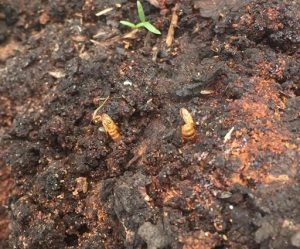
Pupal casings from a peach tree borer. The adult moth has already emerged. This is a sign of a recent infestation.
By Breanna Kendrick
Cory Penca, entomology Ph.D. candidate and a student in the Doctor of Plant Medicine Program at the University of Florida, recently spoke to growers about peach pests at the Stone Fruit Field Day in Citra, Florida. One of the many pests he discussed was peachtree borers.
Peachtree borers are moth species. There’s two different species, lesser peachtree borer and the peachtree borer. Their larvae feed on the wood of the tree, which could lead to loss of limbs and tree death. The lesser peachtree borer lays its eggs and develops on the scaffold limbs and above the trunk of the tree, while the peachtree borer lays its eggs and develops at the base of the tree and below.
There aren’t many curative options, so growers are limited to pest prevention.
One way to monitor for both borers is to use pheromone traps. This type of trap is essentially two parts: a sticky bottom with a plastic or paper roof. When the moth gets to the lure inside the trap, it flutters around and makes contact with the sticky bottom and gets trapped. Penca said these traps are very effective and that in a week or so of placing them, several moths will be captured. “If they are present in the area, you’re very likely to catch them,” he said.
Penca said one way to help identify peachtree borers is by looking for gummosis damage on trees. “Gummosis itself isn’t going to tell you if you have peachtree borers because there are several fungal diseases that can lead to gummosis, and just damage from physical or mechanical injury,” stated Penca. “If you look closer at this gummosis in these areas you might see frass, which will look like a gummy, grainy-like texture that looks like a bunch of tiny pellets that were stuck together in syrup. This is the feces of caterpillars, and they are pushing it out of the wound of the tree. Within these wound sites, you may also find casings of the pupa of the moth. Those casings show you that you have an active infestation. You can remove those casings and come back over time and see if there are new casings. That can help you determine how active the infestation is in your area. If you spray and then you don’t see any new casings next year, you may have succeeded at controlling the infestation.”
During the growing season when there’s peaches on the tree, applications for other pests may help provide some control. However, during the summer when growers are making cover sprays for the dormant season, they still need to control these pests. One method is using trunk sprays of Lorsban to control the peachtree borer.
Penca advised protecting the trees after pruning because there will be new wound sites that may be used for oviposition (the act of laying eggs). “There are some non-chemical methods that are being worked out. One of them is the use of the pheromone to disrupt mating,” said Penca. “The idea is that if the males can’t find the females, the females won’t mate or be able to lay eggs. There’s also been work with nematodes to control these peachtree borers when they are lower down in the tree.”
Share this Post
Fresh Strawberry Imports, Exports Up
April 25, 2024How Much Longer Before Neutral Weather Conditions?
April 25, 2024Clemson Extension Agents Provide Crop Updates
April 25, 2024Blueberry Imports Decreased in 2023
April 24, 2024










